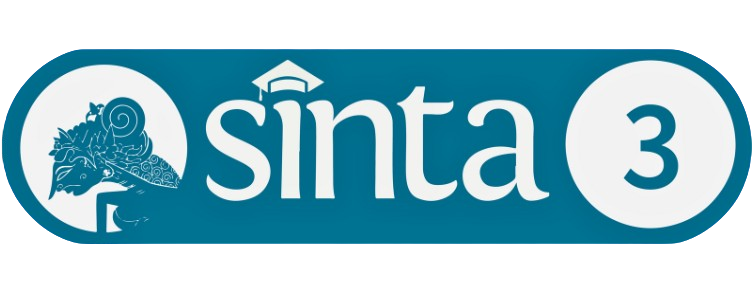Efek Pembingkaian Terhadap Keputusan Beresiko Ditinjau Dari Teori Prospek dan Teori Fuzzy-Trace
Downloads
Risky choice framing adalah salah satu jenis framing yang mencoba mengubah persepsi seseorang dengan melakukan presentasi informasi berdasarkan untung dan rugi. Efek risky choice framing dapat memiliki efek terhadap pembuatan keputusan beresiko. Efek ini dijelaskan menggunakan teori prospek dan teori fuzzy-trace. Kedua jenis teori tersebut memiliki pendekatan yang berbeda dalam menjelaskan risky choice framing. Teori prospek menggunakan pendekatan tradisional dengan mempertimbangkan kombinasi antara kemungkinan hasil yang akan didapatkan. Teori fuzzy-trace menjelaskan proses berpikir yang mengarah pada proses berpikir intuitif dalam memproses sebuah informasi. Hasil eksperimen menunjukkan tidak adanya pengaruh perlakuan eksperimen terhadap pembuatan keputusan beresiko. Hal ini dimungkinkan terjadi karena skenario cerita yang digunakan pada proses eksperimen kurang efektif dalam menyampaikan efek untung dan rugi secara general kepada semua partisipan.
Albert, S., & Duffy. (2012). Differences in risk aversion between young and older adults. Neuroscience and Neuroeconomics, 2012(1), 3. https://doi.org/10.2147/nan.s27184
Anderson, L. R., & Mellor, J. M. (2008). Predicting health behaviors with an experimental measure of risk preference. Journal of Health Economics, 27(5), 1260–1274.
Blanca, M. J., Alarcón, R., Arnau, J., Bono, R., & Bendayan, R. (2017). Non-normal data: Is ANOVA still a valid option? Psicothema, 29(4), 552–557. https://doi.org/10.7334/psicothema2016.383
Fagley, N. S., & Miller, P. M. (1987). The Effects of Decision Framing on Choice of Risky vs Certain Options. Organizational Behaviour and Human Decision Processes, 39, 264–277.
Fagley, N. S., & Miller, P. M. (1990). The Effect of Framing on Choice. Personality and Social Psychology Bulletin, 16(3), 496–510. https://doi.org/10.1177/0146167290163008
Field, A. (2010). Discovering Statistics Using IBM SPSS Statistics, 4th Edition (M. Carmichael (ed.); 3rd ed.). SAGE Publications Inc.
Field, A., & Miles, J. (2010). Discovering Statistics Using SAS. SAGE Publications Inc.
Fischer, F. (2019). Knowledge politics and post-truth in climate denial: on the social construction of alternative facts. Critical Policy Studies, 13(2), 133–152. https://doi.org/10.1080/19460171.2019.1602067
Fisher, S. A. (2020). Meaning and framing: the semantic implications of psychological framing effects. Inquiry, 1–24. https://doi.org/10.1080/0020174X.2020.1810115
Gardner, M., & Steinberg, L. (2005). Peer Influence on Risk Taking, Risk Preference, and Risky Decision Making in Adolescence and Adulthood: An Experimental Study. https://doi.org/10.1037/0012-1649.41.4.625
Grichnik, D. (2008). Risky choices in new venture decisions - Experimental evidence from Germany and the United States. Journal of International Entrepreneurship, 6(1), 22–47. https://doi.org/10.1007/s10843-008-0019-5
Hardisty, D. J., Johnson, E. J., & Weber, E. U. (2010). A dirty word or a dirty world? attribute framing, political affiliation, and query theory. Psychological Science, 21(1), 86–92. https://doi.org/10.1177/0956797609355572
Heilman, R. M., & Miclea, M. (2016). Risk Seeking Preferences: An Investigation of Framing Effects across Decisional Domains. Cognition, Brain, Behavior: An Interdisciplinary Journal, 20(1), 1–16.
Hellinger, F. J. (1989). Expected utility theory and risky choices with health outcomes. Medical Care, 27(3), 273–279. https://doi.org/10.1097/00005650-198903000-00005
Highhouse, S., & Yüce, P. (1996). Perspectives, perceptions, and risk-taking behavior. Organizational Behavior and Human Decision Processes, 65(2), 159–167. https://doi.org/10.1006/obhd.1996.0014
Howitt, D., & Cramer, D. (2011). Introduction to research methods in psychology (3 ed.). Pearson Education.
Igou, E. R., & Bless, H. (2007). On undesirable consequences of thinking: framing effects as a function of substantive processing. Journal of Behavioral Decision Making, 20(2), 125–142. https://doi.org/10.1002/bdm.543
Kahneman, D. (1991). JUDGMENT AND DECISION MAKING: A Personal View. PSYCHOLOGICAL SCIENCE, 2(3), 142–145.
Kahneman, D., & Tversky, A. (1979). PROSPECT THEORY: AN ANALYSIS OF DECISION UNDER RISK. Econometrica, 47(2), 263–291.
Krishnamurthy, P., Carter, P., & Blair, E. (2001). Attribute Framing and Goal Framing Effects in Health Decisions. Organizational Behavior and Human Decision Processes, 85(2), 382–399. https://doi.org/10.1006/obhd.2001.2962
Kühberger, A. (1998). The Influence of Framing on Risky Decisions: A Meta-analysis. 75(1), 23–55. https://doi.org/10.1006/obhd.1998.2781
Kühberger, A., & Tanner, C. (2010). Risky choice framing: Task versions and a comparison of prospect theory and fuzzy-trace theory. In Journal of Behavioral Decision Making (Vol. 23, Nomor 3, hal. 314–329). John Wiley and Sons Ltd. https://doi.org/10.1002/bdm.656
Kusev, P., & van Schaik, P. (2011). Preferences under risk: Content-dependent behavior and psychological processing. In Frontiers in Psychology (Vol. 2, Nomor NOV). Front Psychol. https://doi.org/10.3389/fpsyg.2011.00269
Levin, I. P., Schneider, S. L., & Gaeth, G. J. (1998). All Frames Are Not Created Equal: A Typology and Critical Analysis of Framing Effects. In ORGANIZATIONAL BEHAVIOR AND HUMAN DECISION PROCESSES (Vol. 76, Nomor 2).
Linde, J., & Sonnemans, J. (2012). Social comparison and risky choices. Journal of Risk and Uncertainty, 44(1), 45–72. https://doi.org/10.1007/s11166-011-9135-z
Lusk, J. L., & Coble, K. H. (2005). Risk Perceptions, Risk Preference, and Acceptance of Risky Food. American Journal of Agricultural Economics, 87(2), 393–405. https://doi.org/10.1111/j.1467-8276.2005.00730.x
Morling, B. (2017). Research methods in psychology : evaluating a world of information (3 ed.). W. W. Norton & Company.
Navarro, D., & Foxcroft, D. (2019). Learning statistics with jamovi: a tutorial for psychology students and other beginners. 10.24384/hgc3-7p15
Neuman, W. L. (2014). Social research methods: Qualitative and quantitative approaches (7 ed.). Pearson Education.
Park, N. Y. (2016). Domain-specific risk preference and cognitive ability. Economics Letters, 141, 1–4.
Peng, J., Li, H., Miao, D., Feng, X., & Xiao, W. (2013). Five different types of framing effects in medical situation: A preliminary exploration. Iranian Red Crescent Medical Journal, 15(2), 161. https://doi.org/10.5812/ircmj.8469
Repetto, C., Sek´scí, K., Sek´scí, S., Kusev, P., Purser, H., Heilman, R. M., Cooke, A. J., Schaik, P. Van, Baranova, V., Martin, R., & Ayton, P. (2017). Understanding Risky Behavior: The Influence of Cognitive, Emotional and Hormonal Factors on Decision-Making under Risk. Frontiers in Psychology | www.frontiersin.org, 8, 102. https://doi.org/10.3389/fpsyg.2017.00102
Reyna, V. F. (2004). How People Make Decisions That Involve Risk. Current Directions in Psychological Science, 13(2), 60–66. https://doi.org/10.1111/j.0963-7214.2004.00275.x
Reyna, V. F., & Brainerd, C. J. (1991). Fuzzy"trace theory and framing effects in choice: Gist extraction, truncation, and conversion. Journal of Behavioral Decision Making, 4(4), 249–262. https://doi.org/10.1002/bdm.3960040403
Rothman, A. J., Salovey, P., Bedell, B., Cioffi, D., Dertweiler, J., Lemm, K., Moyer, A., Wegener, D., & Zullo, J. (1997). Shaping Perceptions to Motivate Healthy Behavior: The Role of Message Framing. In Psychological Bulletin Copyright (Vol. 121, Nomor 1). Weinstein.
Scheier, M. F., & Carver, C. S. (1985). Optimism, coping, and health: Assessment and implications of generalized outcome expectancies. Health Psychology, 4(3), 219–247. https://doi.org/10.1037//0278-6133.4.3.219
Schoorman, F. D., Mayer, R. C., Douglas, C. A., & Hetrick, C. T. (1994). Escalation of Commitment and the Framing Effect: An Empirical Investigation. Journal of Applied Social Psychology, 24(6), 509–528. https://doi.org/10.1111/j.1559-1816.1994.tb00596.x
Schwarz, N. (1990). Feelings as information: Informational and motivational functions of affective states. In E. T. Higgins & R. Sorrentino (Ed.), Handbook of Motivation and Cognition. Guilford Press. https://psycnet.apa.org/record/1990-98254-015
Steinberg, L. (2006). Risk taking in adolescence: What changes, and why? Annals of the New York Academy of Sciences, 1021(1), 51–58. https://doi.org/10.1196/annals.1308.005
Tomova, L., & Pessoa, L. (2018). Information about peer choices shapes human risky decision-making. Scientific Reports, 8.
Tversky, A., & Kahneman, D. (1981). The Framing of Decisions and the Psychology of Choice. science, 211, 452–458. www.sciencemag.org
Wang, X. T. (1996). Framing Effects 1 Organizational Behavior and Human Decision Processes Vol Framing Effects: Dynamics and Task Domains (Vol. 68, Nomor 2).
Westfall, J. (2016). PANGEA: Power ANalysis for GEneral Anova designs. http://jakewestfall.org/pangea/
BRPKM is a periodical publication with open access to the Creative Commons Attribution 4.0 International (CC-BY 4.0). Therfore, the copyright remains with the author.
With this license, anyone has the right to use the information and to re-distribute the content contained in this journal for any purpose, including commercial purposes. It can be done as long as it fulfills two conditions, namely; (1) you shall provide attribution by citing the original link source, and state if any changes have been made; and (2) you may not use any legal provisions or technological means of control that can legally restrict others from doing the things that are permitted by this license.
Journal editors will not ask the author to approve the transfer of copyright on all published manuscripts.










